- Bernard Preston homepage
- Easy LUNCH
- Cooking Green Beans
Cooking Green Beans
Cooking green beans is a cinch but first, if you want them really crisp and nutritious then consider growing them too. They are the simplest veg to plant. You put a seed in the ground and come back six weeks later and hey-presto, you have a mountain of fruit.
There are not many things more rewarding that picking the fruit of all your labour. In ten-minutes, having topped 'em, you will be cooking green beans; from your very own garden. There is really no need to tail them; a complete waste of time.
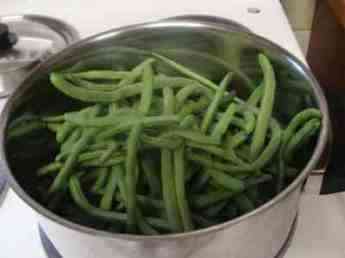
This page was last updated by Bernard Preston on 17th February, 2025.
Pour a small amount of hot water into a pot, perhaps half a centimetre deep, bring it to a boil, toss in the whole beans and put the lid on.
Assuming they are nice and young, about two-minutes of hard boiling is enough. Turn the stove off, and they'll go on cooking for a short while. Drain, retaining the water; that is where many of the minerals may be lost.
Bush beans have the advantage in that they are quick. You will have a crop in about six-weeks. So they are the choice way of growing them in early spring after all danger of frost is over.
Pole beans
For me though I would rather grow pole-beans.
Or as we call them in Africa, climbing beans. You would be astonished at the crop you will get off just three or four poles.
Not enough for a green-bean casserole or salad recipe but sufficient for one person.
Pole beans bear for much longer too; and if you get unexpected heavy rain they will not get mildew. Just plant two or three seeds every week.
But for our family, I plant three times, perhaps fifty beans on a homemade-trellis. We eat them morning, noon and night through the summer.
They are a staple in our lives in an attempt to reduce our need for red-meat for protein.
Build a trellis or teepee
You need either a fence or three poles in the ground, as in a teepee; we now turn it into a trellis preferably more than six-feet high; climbing beans grow tall.
Beans are tremendous food, rich in protein and resistant carbohydrate but to get full value, you need some compost.
Start by digging a row of holes roughly a foot deep and a metre apart. Press the pole in as deeply as you can and fill it with whatever humus you have.
Actually now we use kitchen waste that has been processed in our worm farms; they rapidly turn it into vermi-compost.
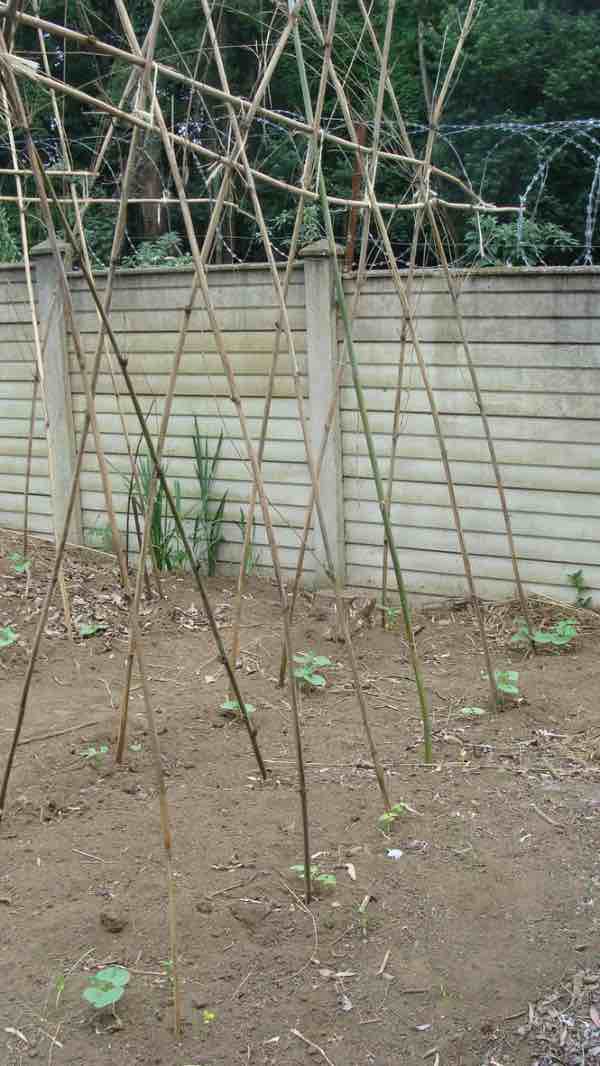
They're not fussy but if you want quality beans, buy or make the compost. It is good for the environment too if you can use all your kitchen-waste in the garden. Potato and banana peels are perfect; all the organic material from old flowers and grass cuttings too.
No cooked food though should go in the compost heap; put that into the worm farm. If you haven't started one, now is the time; it means no food for rats, plenty of liquid manure and a surplus of creepy-crawlies for your garden. And, if you keep them, the hens will go crazy over a gourmet meal.
Some of the best humus comes from old logs, only it takes longer. Here's a giant pile of wood that has come out of the jungle that was formerly my apiary before we went for a 7 year stint in Holland. I must have bees again so instead of burning these sticks, we will compost them; the earthworms love them.
In case you are unsure, beans are legumes, full of vegetable protein; that means less beef. I'm sure you know that processed-meat like bacon is definitely only for high and holy days.
The WHO says that even straight red meat is "probably" tumour-causing. Certainly no more than once a day; and preferably only a few times a week.
If you can get grass-fed beef or free range pork that may be different.
What are legumes in case you don't know. They are also the chief source of nitrogen in the soil for your plants.
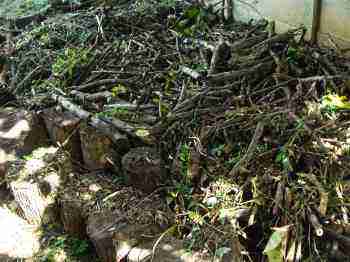
Growing Green Beans
Growing green beans is just as easy as cooking them. Our hens have latterly contributed enormously to our eco-garden, providing manure and sorting out the beetles.
But beware, the birds need large amounts of protein for their eggs; they'll demolish your seedlings without a chicken-tractor of some sort or protection with a vegetable garden fence.
Whilst in the early days I was hot on a chicken tractor design I now allow the birds to roam freely with little cages around the sensitive seedlings. Free-range eggs are a must in our home for the choline and rich, bright yellow yolks.
- Making a compost pile for yourself.
Cover the compost with a few inches of soil and then make a drill about a centimetre deep. Plant the seeds 6" apart and cover with fine humus from the worm farm if you have one. Growing green beans are very hardy, the roots go deep into the ground so you don't have to fuss if you have a dry period.
Water obviously if it gets really dry, particularly around flowering-time.
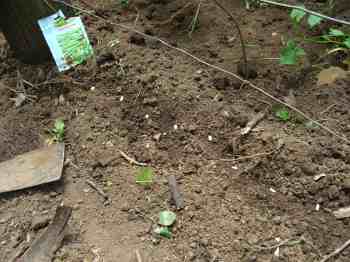
The other advantage of pole beans is that they are so easy to pick. With the bush variety, you might require a couple visits to your DC after all the bending.
"Lower back exercises" done faithfully every morning before arising are the secret to success with lumbago; they take less than two-minutes and are a whole lot better than surgery. Find out more using the Site Sell function key in the menu bar above.
And you thought this page was going to be all about cooking green beans. Not so, that is the easy part; growing them and then steaming the fruit for a few minutes after you have picked the pods is first prize.
After all the years of hard work at the coalface, a long retirement is well deserved; but still has to be earned. Plenty of exercise and a low refined carbohydrate diet is an important part of the deal; less than say 130g per day. A third of that or less if you are diabetic.
Frailty and vitamin E is an important subject; green beans are a surprisingly good source.
When the world wearies
and society ceases to satisfy,
THERE'S ALWAYS THE GARDEN!
This is how they will look after about six-weeks. Shooting up like Jack in the Beanstalks; and very soon the first flowers will be appearing. Those are maize plants in the background. And a few weeds that need my attention.
Last year our beans were hit hard by stink bugs that stung the fruit. They are sap-sucking insects; this year I am going to try using this homemade product from white oil manufacturers that we make up; you don't need to buy it.
Better still turned out to be growing them in with a crop of lima beans; that camouflaged the fruit from the stink bugs.
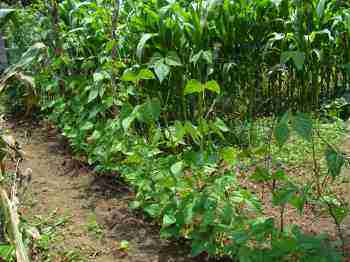
In your mind's eye, can you see a delicious healthy SUCCOTASH RECIPE on the table? Corn and green beans are a perfect match.
Cooking Green Beans
Cooking green beans is a cinch. We do top them, but don't bother any more with tailing.
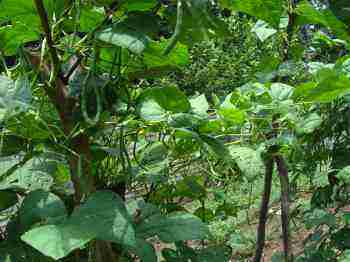
If the rest of your supper is ready, scoop them straight onto the hot dinner-plates. If your cholesterol is in shape, smother them with some fresh butter.
But if your cholesterol is not in good shape do not take statins; there is no research showing they will add a day to your life unless you have already had a heart-attack.
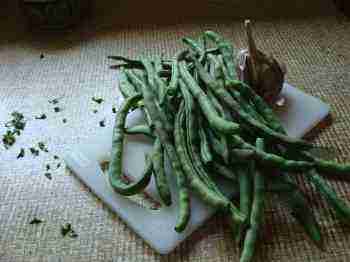
Contaminants
The honest truth is that when you buy green beans either fresh from the supermarket, frozen or canned you have little idea what contaminants there may be.
Just this week small pieces of glass in their frozen green beans prompted McCain to do a product-recall[4]. Just as worrying are the toxic poisons used in growing them that you cannot visualise; herbicides, for example. What the eye cannot not see, the mind does not worry about it.
Newsletter
Our newsletter is entitled "create a cyan zone" at your home, preserving both yourself and Mother Earth for future generations; and the family too, of course. We promise not to spam you with daily emails promoting various products. You may get an occasional nudge to buy one of my books.
Here are the back issues.
- Lifestyle and ideal body weight
- What are ultra-processed foods?
- Investing in long-term health
- Diseases from plastic exposure
- Intensive lifestyle management for obesity has limited value
- A world largely devoid of Parkinson's Disease
- The impact of friendly bacteria in the tum on the prevention of cancer
- There's a hole in the bucket
- Everyone is talking about weight loss drugs
- Pull the sweet tooth
- If you suffer from heartburn plant a susu
- Refined maize meal and stunting
- Should agriculture and industry get priority for water and electricity?
- Nature is calling
- Mill your own flour
- Bake your own sourdough bread
- Microplastics from our water
- Alternative types of water storage
- Wear your clothes out
- Comfort foods
- Create a bee-friendly environment
- Go to bed slightly hungry
- Keep bees
- Blue zone folk are religious
- Reduce plastic waste
- Family is important
- What can go in compost?
- Grow broad beans for longevity
- Harvest and store sunshine
- Blue zone exercise
- Harvest and store your rainwater
- Create a cyan zone at your home
Think rather of eating foods that will lower your cholesterol naturally. It works, dinkum. My cholesterol is 4.2 and just ask Helen, I eat far more butter than is supposedly good for one.
But then I do enjoy Helen's 15-euro salad several times a week. And in the summer, I get plenty of practice at growing and cooking green beans.
Growing green beans is good exercise; and cooking and eating them will keep your cholesterol profile in order.
It's refined carbohydrate, not butter, that is the devil. Did you know that 120 years ago, the average person ate 4kg of sugar per year. And today it is over 50; there is the problem, along with cake flour and white rice not the starch in green beans.
- FOODS THAT LOWER CHOLESTEROL ...
- HELENS 15 EURO SALAD; constipation, diverticulosis and malignant bowel disease all prevented in one dish.
Nitrogen-fixation bacteria
Nitrogen-fixation bacteria in the roots of legumes provide that vital element, for synthesising our protein and all the other plants in the garden that like us are dependent on these bugs for capturing the gas from the air.
Our bodies require abundant amounts of nitrogen from our food to manufacture amino acids, the building-blocks of living tissue.
The beauty of legumes like growing lima beans in our gardens is that they reduce our reliance on amino-acids from red meat and dairy; there is now abundant evidence that animal protein eaten in excess, causes many malignant diseases, especially when processed.
Research in Holland which has the highest rate of breast tumours
in the world indicates that red meat, dairy and eggs, eaten in excess are the chief cause; and hormone replacement therapy. Ham for breakfast is madness.
Could free-range eggs and pork from pigs living in a forest be different? I think so, but I can find no research confirming it.
Breast tumours and prevention should be on the agenda in every family; it doesn't just happen to other people.
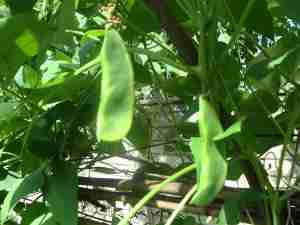
Cooking green beans is so quick and rewarding.
If you have a glut then find out how to thicken curried green beans without cornstarch.
Mexican bean beetle
Mexican bean beetles are a serious impediment to your desire to grow and cook green beans. One bug will lay over a million eggs that will turn into larvae, bar those taken by ladybirds and small birds.
There are some green organic-solutions, but it remains a serious pest.
Another serious pest is your own chickens, if you have any. They desperately need vegetable protein to lay those lovely organic eggs.
There are compromises and solutions if you want free range eggs. They are loaded with omega-3, so desperately short in the average diet resulting in inflammation, pain and tumours; and attention deficit too.
Green Bean Salad
A green bean salad is my favourite way of enjoying this wonderful legume. It's also quick and easy.
In five minutes after cooking green beans, your vegetable protein salad will be ready for the table. Perhaps less, believe you me, I'm the one who makes it! Well, sometimes!
INGREDIENTS for your green bean salad
- A good handful of raw green beans, depending on how many guests you have coming to lunch.
- One or two shallots, spring onions. Or just a few slices of an ordinary onion.
- Freshly squeezed juice of one lemon.
- One (or more) clove of garlic, freshly chopped.
- A good slosh of olive oil.
- Salt and pepper.
- Optional: finely chopped parsley.
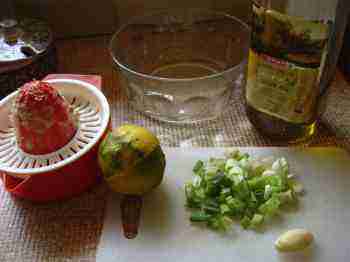
- Cooking green beans as above.
- Squeeze the lemon, pouring the juice into a glass
bowl, together with a little of the water you cooked the beans in.
- Add
your olive oil, S&P and mix it up.
- Toss in the chopped shallot and clove of garlic. Stir.
- Add the hot chopped, cooked green beans. Ladle the juice over the beans.
What could be easier?
PS: We need to educate our tongues to the fact that not
everything must be sweet. But if you insist, add a teaspoon of raw
honey.
Make it pretty with some slices of tomato and a sprinkling of fresh
parsley, and it's GRUB'S UP. Time permitting, it's good to wait for a
while for the flavour of the garlic and herbs to permeate the beans.
Update: I've been experimenting with a new herb to me; it's called sweet basil and you're probably familiar with it. A few freshly chopped leaves in your cooking green beans salad make for a lovely change. Scroll down past making a correct diagnosis to sweet basil and how to make pesto.
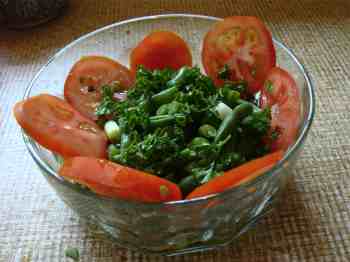
Three bean salad recipe
Three bean salad recipe means just adding half a can of baked beans, and another of limas.
Limas are often known as butter beans.
Another of our favourites are these green bean succotash recipes. It is really very simple when the corn is a little too mature to enjoy straight off the cob. Direct from the garden, like new potatoes, they don't cause a high glycemic response; read, they do not make you fat.
Here is the rest of my lunch today. I always like to add a fat (like avocado, or cold wate fish) to my bread because of commercial bread's high glycemic index.
Adding fat or protein, or something like hummus which has a very low glycemic index will reduce the insulin rush that just plain bread, white or brown, gives. It is soluble fibre that slows the absorption of sugars into the blood stream.
Cooking green beans are full of fibre.
CARBOHYDRATE COUNT CHART and understanding GLYCEMIC INDEX ...
A protein dish always adds to a salad, today it's just half a block of
feta cheese. But perhaps a leg of free range chicken, or a few slices of
mutton.
It's widely recognised today in nutritional circles that if you want to
be happy and healthy you need at least FIVE coloured fruit and veg each
and EVERY day. Frankly, I think that is far too little. We aim for ten;
in my lunch today I have at least eight, can you count them? More than
cooking green beans.
Anyway even if you have no desire to live to be a healthy ninety with all your marbles intact, MY LUNCH TASTES DIVINE! As we said in Holland, "Eet smakelijk." Enjoy!
Red meat max once a day remember, probably three times a week max; get more protein from legumes, fish and fowl.
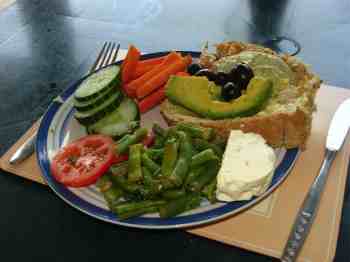
Phytochemical Foods
Phytochemical foods keep the big C at bay and mostly they are delicious; lightly cooking green beans is important; they are heat labile.
Beans too contain a wide array of the plant chemicals that are known to have a vital function in health; but because there are thousands of them, scientists have only begun to scratch the surface.
They make up the colouring in green beans, known as flavonoids, and it's now known that they have an important role preventing the absorption of cholesterol from the gut, for example.
They are the reason why we should be eating a minimum of five coloured foods each day; I aim for ten, if in small quantities. A sprig of parsley might count for one.
They have an antioxidant and anti inflammatory effect in the body. If you're interest, read up more about phytochemical foods. The flavonoids in beans, the lignans in flaxseed, the stanols in avodcados and olives, the terpenes, the cartonenoids, the indoles and so on; thousands of them. Make sure you are getting as many as possible by eating from a wide array of foods. Meat and potatoes man? There's trouble coming.
Oxidation
Free radicals attack our cells, robbing of them of their electrons. Antioxidants help prevent this process by supplying negative ions. Green beans are a good source, as are most coloured vegetables.
Save Bean Seed
At the end of the summer you'll find that there are a few pods that you have missed. This is the time to SAVE BEAN SEED for next year's crop. Save time, save money, save the planet, keep your own seed.
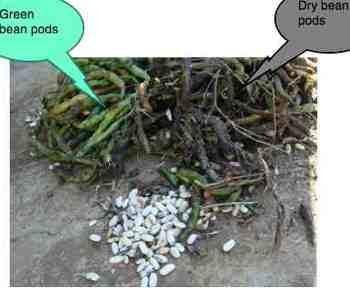
Growing Lemon Trees
Food lover? Then you absolutely must have a lemon tree in the garden. The Meyer lemon is the most beautiful small tree, with bright yellow fruit, scent in the Spring that is divine, and lemon juice oddly is one of the few fruits that, despite the citric acid, actually acts as an alkalising agent in the body. Taste fantastic, looks beautiful, is healthy, what more do you want? Essential for COOKING GREEN BEANS.
I've just planted my first lime tree, even nicer that the lemon my brother tells me. Growing lemon trees is not difficult.
Dips, Pâté and Soup to go with COOKING GREEN BEANS
GREEN BEAN AND LENTIL SOUP was good enough for Andre Agassi before a match, and it's good enough for me!
"Dips made with cream cheese" are great unless you're allergic to dairy. Type it into the Site Sell key.
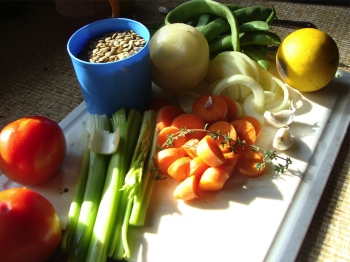
Green bean succotash recipes
Corn and beans out of a can is definitely only fit for hogs (taste-wise) but, straight from the garden, green beans and fresh corn is to die for. Healthy, full of fibre, very low glycemic index, high in protein, full of phytosterols ... plain good food. GREEN BEAN SUCCOTASH RECIPES ...
Gigantes butter beans recipe
This giant butter beans recipe is for another delicious nutritious Greek dish.
Other than soaking the legumes overnight, it can be made in a jiffy. Wonderful good stuff, high in protein, low in fat and carbohydrate with a low glycemic-index.
Butter beans are just dried limas.
Growing lima beans
Another wonderful plant protein can be obtained from the lima bean. It's not a legume that you'll find fresh in your green grocer, so you'll have to grow it yourself. Sufferin' succotash, this is a marvellous bean.
Quite a lot of PT unfortunately, but so rewarding, if anything even nicer than pole beans. GROWING LIMA BEANS on a vegetable garden trellis is one of my favourites; it's now late summer and we are enjoying the first fruits.
The glycemic response to legumes, with the exception of broad beans, is very low by the way; they don't make you fat. The latter are a must because of their prevention of Parkinson's disease, but must be enjoyed in the context of the whole meal, rich in fibre, other protein and some fat all of which the rapid digestion of the starch in the small intestine.
Apologies if you are hunting for green bean cassarole and three bean salad recipe - a page for next summer when we have more cooking green beans. Midwinter now in the southern hemisphere.
Freezing green beans
Often it's feast or famine with green beans. It is simple to preserve them.
- Wash them thoroughly and allow them to dry for 20 minutes.
- Top and tail them, and cut them in half.
- Place them in a plastic bag, suck the air out and tie a knot.
- Pop them in the freezer.
With thanks to 365 Economist for many useful tips on how to store your foods[1].
Vitamins and minerals
Growing and cooking green beans also means also a rich supply of vitamins such as C and K; and some of the B-complex too. Manganese is needed to build connective tissue in the body; muscles, ligaments and bones, for example.
From to start to finish, cooking green beans is beneficial to our well-being.
Useful links
When browsing use right click and "Open Link in New Tab" or you may get a bad gateway signal.
A DAY IN THE LIFE OF BERNARD PRESTON DC makes me dizzy on reflection; goodness how busy I was before going into semi-retirement. Now I have time to focus on my hobbies, particularly backyard permaculture and healthy living.
A life without medication is truly one of the great blessings; but comes only to those who have made a commitment to plenty of exercise and good food like cooking green beans.
Getting most of our protein from legumes like green beans gives us a greater chance of enjoying a "life without medication." Find out how using the Site Search function key.
Did you find this page interesting? How about forwarding it to a friendly book or food junkie? Better still, a social media tick would help.
- Bernard Preston homepage
- Easy LUNCH
- Cooking Green Beans
Address:
56 Groenekloof Rd,
Hilton, KZN
South Africa
Website:
https://www.bernard-preston.com